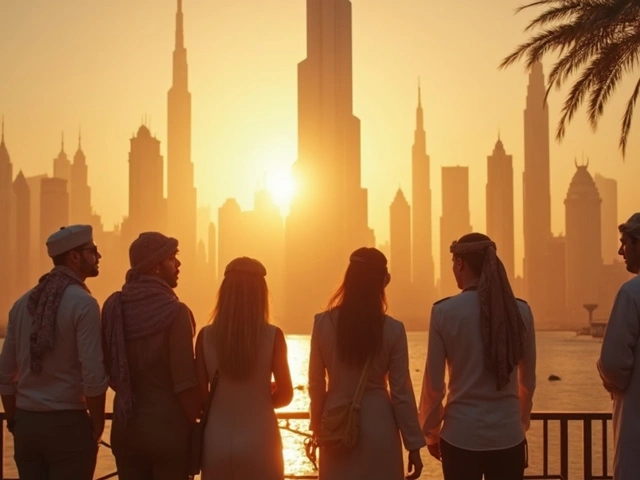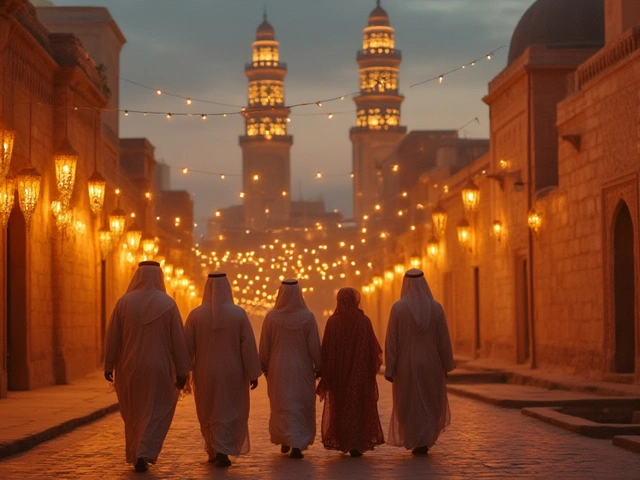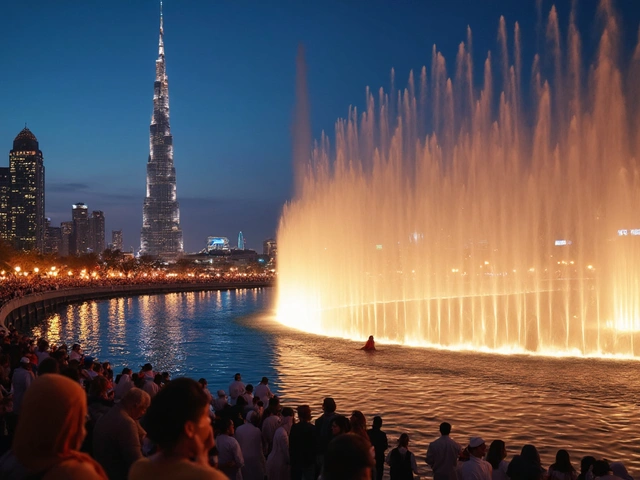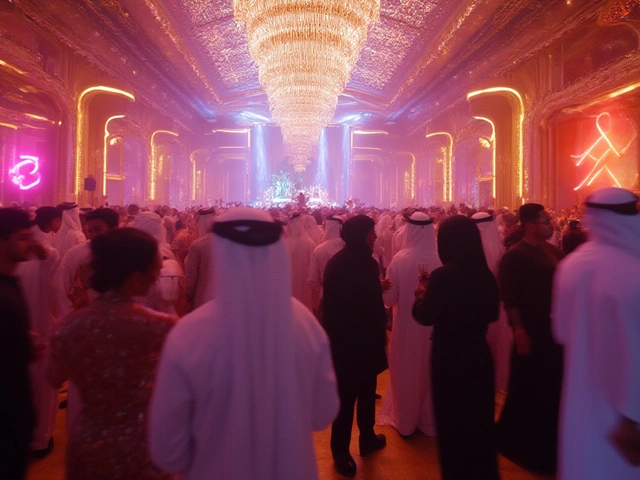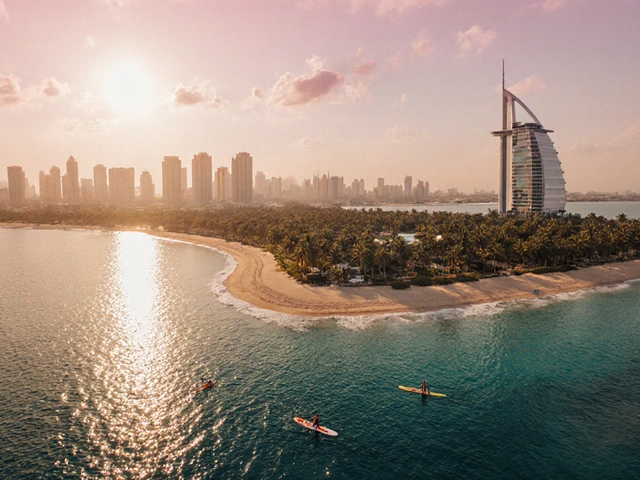You know Dubai doesn’t do boring. Among its wild skyline and endless wow-factors, the Dubai Frame manages to hold its own, looking right out of a sci-fi dream, but stuffed with stories from centuries past. This sky-high rectangle treks upward in Zabeel Park but you’ll find it’s much more than just another Instagram trap. Dubai Frame is a symbol, a museum, an engineering feat, and—maybe unexpectedly—a love letter to both Old and New Dubai.
The Towering Story: Why Dubai Frame Exists
The Frame didn’t just pop up overnight. Its golden façade is an open invitation to glimpse two eras of the city at once. Emirati architect Fernando Donis won an international competition in 2009 with the idea to ‘frame’ the old and new city vistas. By 2018, the 150-meter-tall and 93-meter-wide rectangle was ready to welcome its first crowds. It’s nestled right at the bridge between Bur Dubai (with its winding, historic souks) and the glass towers of Downtown, making it a physical and visual border of two Dubais. Walk the glass-floored Sky Deck, and on one side you see the raspy beige of Al Fahidi’s wind towers; spin around, you’re staring at the futuristic sprawl of Sheikh Zayed Road, including Burj Khalifa itself.
This isn’t just a feat of clever design; every element, right down to the honeycomb pattern covering the exterior, pays its dues to local tradition. It reflects the golden ratio often found in Islamic art and hints at palm fronds—no accident for a city grown from the desert. Even the location within Zabeel Park isn’t random; it’s one of Dubai’s largest green lungs, a spot Emiratis and long-terms expats know for picnic weekends and running tracks, right in the middle of the chaos.
In the age where Dubai flips the switch on mega-projects every other year, the Frame stands out for doing more than just ‘being big’. It dares to start conversations on memory. The lower floors house a museum-style exhibit that takes you on an immersive stroll through the city’s roots. Step inside and you’ll wander through foggy dioramas of old fishing and pearl-diving villages, made extra rich with personal stories from some of Dubai’s oldest families.
Love collecting trivia? Here’s a winner for your next dinner party: The Dubai Frame uses 2,900 square meters of laminated glass and nearly 15,000 square meters of gold-colored stainless steel cladding. Climb into the elevator (not for the faint of heart, unless you love a glass wall) and you shoot up to the sky in just 75 seconds. There’s even talk that upwards of one million visitors streamed through in its very first year.
Beyond the Frame: What You’ll Actually Experience
Walking toward the Frame, it’s pure drama—from the long palm-shaded boulevards to the shine bouncing off that gilded skeleton. Tickets are reasonably priced by Dubai standards (think under AED 60 for adults), and if you’re a UAE resident, you can hop the queue by grabbing tickets online from Dubai Municipality’s site. For families, it’s stroller-friendly, and for those with mobility needs, there are ramps and dedicated elevators, which isn’t always the case in older Dubai attractions.
Once inside, the journey mimics time travel. The ground-floor ‘Past Gallery’ paints a surprisingly vivid portrait of life before oil. Think pop-up markets, boat launches, heaps of traditional Emirati dishes steaming away, and even the early pearl trade. They use AR and VR, but it doesn’t feel forced or gimmicky—a rarity for tourist spots anywhere.
- Sky Deck Walk: The highlight, no contest. The bridge’s glass floor flips opaque to clear as you step on it—cue nerves—but this is exactly the kind of safe thrill even cautious folks will rave about, since it never feels unstable or rickety.
- 360-degree Panoramas: Interactive screens label what you’re seeing, so you’ll finally know if that’s actually the museum in Deira or just wishful thinking. Don’t skip dusk, when the gold of the Frame lights up and the city transitions from day to night in a rush of colors.
- Future Dubai Gallery: Heading downward, you’re dropped into an eerie tunnel that promises a look into "what’s next." The projections here are wild—flying taxis, robots cleaning the beaches, and even climate-controlled domes (some of which aren’t as far-fetched as you might think).
Pro tip: The Frame never gets as swamped as Burj Khalifa’s viewing deck. Sure, weekdays see local schools on field trips, but it’s always possible to find a quiet corner up top, especially in the morning. And here’s a lesser-known hack—during UAE National Day or Eid, you can catch themed illuminations on the frame itself, tethering the monument even deeper to the city’s annual rhythm.
Framing Dubai Culture and Identity
People in Dubai know the city is in a unique race—change races ahead, but old roots aren’t forgotten. The Frame isn’t just a sightseeing spot; it’s an identity checkpoint. In a rare move for a shiny new attraction, it gives equal love to the Emirates’ humble beginnings and its global ambitions.
In 2024, researchers from Zayed University published a study (yes, a real one) underlining how public spaces like the Frame help bridge generational gaps: families with Emirati parents and Gen Z kids, recent expats, and tourists all rub shoulders while soaking up different versions of Dubai’s story.
“The Dubai Frame is more than an architectural marvel; it’s a living conversation between what we remember and what we hope for,” said Dr. Reem Al Harthi, a scholar in urban heritage.
If you’re attending events like the Dubai Shopping Festival or City Walk pop-ups, you’ll see the Frame decorated in snazzy colors and local motifs. Ramadan months bring night-time projections and charity iftar giveaways at Zabeel Park, led by big local brands like Al Islami Foods and du Telecom. Sometimes, you’ll even find yoga classes or storytelling events for kids hosted up on the Sky Deck—sunrise stretch, anyone?
The Frame has become a regular feature on everything from wedding photo shoots to influencers’ "best of Dubai" lists—just check the #DubaiFrame hashtag for a scroll-stopping dose of perspective. Even more traditional residents have slowly adopted it as a symbol that Dubai’s future can thrive without erasing its beginnings.
What’s even cooler is that the Frame is now a template for copycats in other parts of the world. Riyadh’s Ministry of Culture has floated plans for a similar ‘frame’ project, and conversations in Singapore and Shanghai have cited the Dubai Frame as inspiration. It’s gone from a city curiosity to something like a civic pride badge.
Insider Tips: Making the Most of Your Visit
Locals will tell you: timing is everything. If you want those uninterrupted city views and fewer crowds, aim for weekend mornings just after opening or grab sunset tickets and prepare for a change in the city’s vibe. The light show in the evening is short but memorable—and amazing for night shots.
Don’t rush the exhibits. The least crowded hours are usually after 2 pm, when school trips die down. Bring a decent camera or make use of the special selfie spots (they’re marked, so you won’t miss them). Not every souvenir shop is worth the stop, but the one downstairs sells gold-plated miniatures and surprisingly chic magnets you won’t find in the tourist souks.
If you’re looking to treat family or guests to a Dubai day out, combine the visit with a picnic or an e-scooter ride through Zabeel Park. The park hosts seasonal farmers’ markets—often on Saturdays between November and March—packed with homegrown goods from UAE’s farm cooperatives, plus fresh dates and Emirati honey. Don’t forget your reusable water bottle; Dubai heat, especially in July and August, means you’ll need to hydrate hard.
The on-site café serves up standard fair—think coffee, karak chai, pastries—with unbeatable window views over the older quarters of Dubai. If you’re feeling extra, book advance tickets during city-wide events like Dubai Summer Surprises, when nearby family parks go all-out with entertainment zones and pop-up food trucks.
| Best Months to Visit | Usual Ticket Price (Adult) | Peak Visitor Times |
|---|---|---|
| October to April | AED 50-60 | Weekends, holidays, sunset hours |
| May to September | AED 50-60 | Noon-3 PM (hottest part, lighter crowds) |
Want a souvenir but tired of generic snow globes? Head to the tiny booth outside and look for custom coins minted with the Frame’s design—a hit among local coin collectors and a great gift for relatives abroad.
Some practical reminders: Large bags aren’t allowed; pack light. Dress respectfully (shoulders and knees covered), not just for the city’s modesty codes but also because the air conditioning inside can get downright chilly. Finally, double-check if sections are closed for maintenance—updates are always posted on Dubai Municipality’s Instagram and X accounts the morning of.
Dubai’s skyline may keep shifting, but the Frame’s mix of nostalgia and sci-fi is unlikely to go out of fashion. It captures what it feels like to live in the UAE right now—torn between heritage and bold leaps into tomorrow, staring out from one sun-splashed side of the city to the next dream being built on the far horizon. And that might be the most Dubai thing of all.


